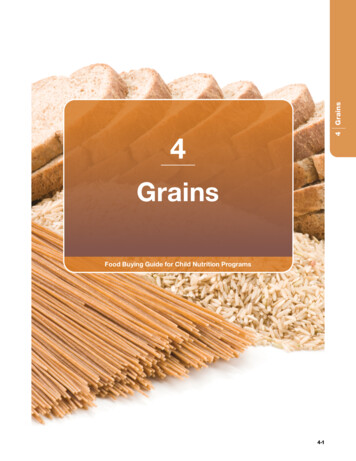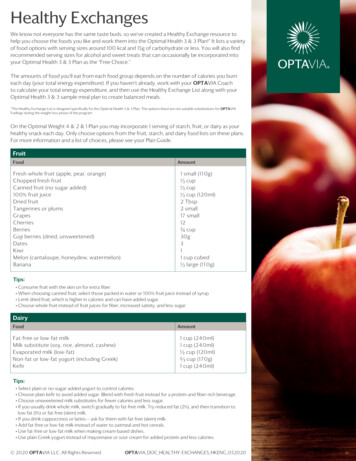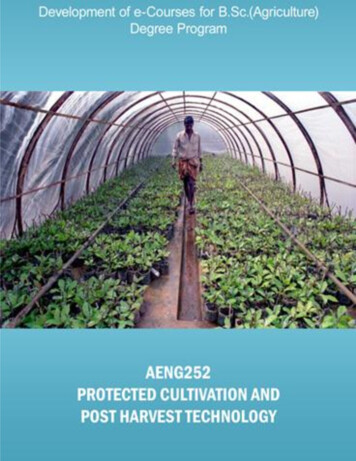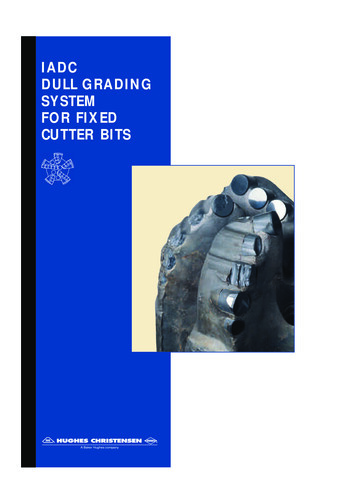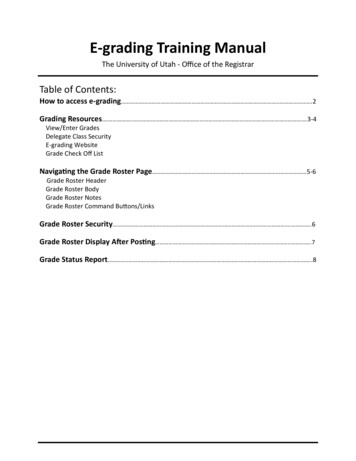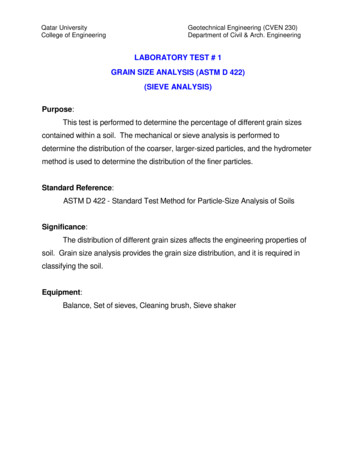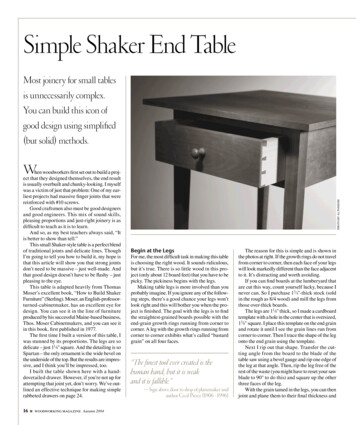
Transcription
United StatesDepartment ofAgricultureMarketing ederal GrainInspectionServiceWashington, D.C.October 2020Grain InspectionHandbookBook IIGrain GradingProcedures
United States Department of AgricultureAgricultural Marketing ServiceFederal Grain Inspection ServiceProgram HandbookOctober 2020Grain Inspection Handbook – Book II Grain Grading ProceduresForewordThe effectiveness of the official U.S. grain inspection system depends largely on aninspector’s ability to sample, inspect, grade, and certify the various grains for whichstandards have been established under the United States Grain Standards Act(USGSA), as amended. In view of this fact, the Federal Grain Inspection Service(FGIS) published the Grain Inspection Handbook.Book II, Grain Grading Procedures, sets forth the policies and procedures for gradinggrain in accordance with the Official United States Standards for Grain. Theinformation contained in this handbook is applicable to official grain inspectionservices performed by FGIS, delegated State agencies, and designed State andprivate agencies. Persons interested in obtaining official services may contact anyFGIS field office or official agency.Trade names are used solely to provide specific information. The mention of tradenames does not constitute a guarantee or warranty of the product by the U.S.Department of Agriculture (USDA) or an endorsement by the Department over otherproducts not mentioned.In accordance with Federal civil rights law and U.S. Department of Agriculture (USDA) civil rights regulations andpolicies, the USDA, its agencies, offices, and employees and institutions participating in or administering USDAprograms are prohibited from discriminating based on race, color, national origin, religion, sex, gender identity(including gender expression), sexual orientation, disability, age, marital status, family/parental status, income derivedfrom a public assistance program, political beliefs, or reprisal or retaliation for prior civil rights activity in any programor activity conducted or funded by USDA (not all bases apply to all programs). Remedies and complaint filingdeadlines vary by program or incident.Persons with disabilities who require alternative means of communication for program information (e.g., Braille, largeprint, audiotape, American Sign Language, etc.) should contact the responsible agency or USDA’s TARGET Centerat (202) 720-2600 (voice and TTY) or contact USDA through the Federal Relay Service at (800) 877-8339.Additionally, program information may be made available in languages other than English.To file a program discrimination complaint, complete the USDA Program Discrimination Complaint Form, AD-3027,found online at How to File a Program Discrimination Complaint and at any USDA office, or write a letter addressedto USDA and provide in the letter all of the information requested in the form. To request a copy of the complaintform, call (866) 632-9992. Submit your completed form or letter to USDA by: (1) mail: U.S. Department ofAgriculture, Office of the Assistant Secretary for Civil Rights, 1400 Independence Avenue, SW, Washington, DC20250-9410; (2) fax: (202) 690-7442; or (3) email: program.intake@usda.gov.USDA is an equal opportunity provider, employer, and lender.Distribution: FGIS, OSP, Grain IndustryOriginating Office: FMD, PPMAB
TABLE OF CONTENTSCHAPTER 1: GENERAL INFORMATIONCHAPTER 2: BARLEYCHAPTER 3: CANOLACHAPTER 4: CORNCHAPTER 5: FLAXSEEDCHAPTER 6: MIXED GRAINCHAPTER 7: OATSCHAPTER 8: RYECHAPTER 9: SORGHUMCHAPTER 10: SOYBEANSCHAPTER 11: SUNFLOWER SEEDCHAPTER 12: TRITICALECHAPTER 13: WHEATCHAPTER 14: REVISION HISTORY
CHAPTER 1:GENERAL INFORMATIONCONTENTS1.1DEFINITIONS . 1-11.2STANDARD ABBREVIATIONS. 1-21.3VISUAL GRADING AIDS . 1-41.4WORK RECORDS . 1-51.5PRELIMINARY EXAMINATIONS . 1-51.6BASIS OF DETERMINATION . 1-51.7SUBMITTED SAMPLE INSPECTIONS . 1-61.8FGIS-APPROVED DIVIDER . 1-71.9ODOR . 1-81.10MOISTURE METERS . 1-101.11TEST WEIGHT PER BUSHEL APPARATUS . 1-111.12CARTER DOCKAGE TESTER . 1-131.13MECHANICAL SIEVE SHAKER . 1-151.14BARLEY PEARLER . 1-171.15LABORATORY SCALES . 1-181.16ROUNDING. 1-191.17EQUIPMENT AND MATERIALS . 1-201.18FILE SAMPLE RETENTION (GRAIN) . 1-231.19UNOFFICIAL INSPECTION SERVICES . 1-251.20METRIC SYSTEM. 1-26
TABLESTABLE 1.1 – TEST WEIGHT PER BUSHEL CONVERSIONS . 1-12TABLE 1.2 – DOCKAGE TESTER CONTROL SETTINGS AND SIEVES . 1-14TABLE 1.3 – FACTORS THAT REQUIRE SIEVING . 1-15TABLE 1.4 – REQUIRED DIVISION SIZES . 1-18TABLE 1.5 – CERTIFYING PERCENTAGES AND TEST WEIGHT . 1-19TABLE 1.6 – FILE SAMPLE RETENTION . 1-23TABLE 1.7 – CONVERSIONS . 1-26TABLE 1.8 – EQUIVALENTS . 1-26TABLE 1.9 – MEASURES . 1-27FIGURESFIGURE 1.1 – CARTER DOCKAGE TESTER FLOW CHART . 1-13CHARTSCHART 1.1 – PROCESSING ORIGINAL SAMPLE . 1-7ATTACHMENTSATTACHMENT 1: GRAMS TO TEST WEIGHT PER BUSHEL (LB/BU). 1-28ATTACHMENT 2: TEST WEIGHT PER BUSHEL/KILOGRAM PERHECTOLITER CONVERSION. 1-37
1.1DEFINITIONSFile Sample. The extra unworked portion cut from the representative sample thatmay be used in conjunction with the work sample when needed.Samples retained for grade should be approximately 1,400 grams or more,except for the lighter grains (e.g., oats or barley) that require less grain todetermine grade.For factor only tests or official criteria (e.g., wheat protein or falling number),smaller file samples should prove sufficient to handle review services.File samples larger than 1,400 grams may be retained if deemed necessary toprovide subsequent inspection service.Kind of Grain. A determination as to whether a sample meets the definition of aspecific grain or oilseed as established in the Official U.S. Standards for Grain.Official Agencies (OA). State and private partners authorized by FGIS to provideofficial inspection and weighing services to the domestic and export grain tradeon FGIS behalf.Official Personnel. Any authorized Department employee or person licensed byFGIS to perform all or specified functions under the Act.Official Service Providers (OSP). Federal offices and State and private agenciesauthorized by FGIS to provide official inspection and weighing services to thedomestic and export grain trade.Representative Portion. A specified quantity of grain divided out from therepresentative sample by means of an FGIS-approved device.Representative Sample. The terms “Representative Sample” and“Original Sample” are used interchangeably in the Grain InspectionHandbook. Both terms refer to a sample size of approximately 2,5003,000 grams in size drawn from a lot by official inspection personnelusing approved procedures and sampling devices. For more informationon sampling, refer to Book I, “Sampling Procedures.”Review Inspection. All follow-up grade inspections available (reinspection,appeal, or board appeal).Work Sample. A representative portion of grain; approximately 1,000 - 1,050grams, used to make determinations required for a particular grain.Chapter 1 – General InformationOctober 1, 2020Grain Inspection Handbook IIGrain Grading ProceduresPage 1-1
1.2STANDARD GKAdmixtureAmber Durum wheatAnimal FilthAngoumois mothsBadly stainedBadly weatheredBarleyBird excretaBleachedBlightBlue aleuroneBlue barleyBlue Malting barleyBottom not sampledBrightBroken cornBroken corn and foreign materialBroken glassBroken kernelsBroken kernels and foreignmaterialCanolaCastor beansClassCoarseCocklebursCommercially objectionableforeign odorContrasting classesConspicuous admixtureCornCrotalariaCultivated sunflower seedDamaged kernelsDamaged kernels (total)Damaged seeds (total)Dark, Hard, and VitreousDark Northern Spring wheatDefects (total)DehulledDentDiatomaceous earthDistinctly discoloredDistinctly green istinctly low qualityDockageDurum wheatDyedErgotyErucic acidExtra heavyFine foreign materialFlaxseedFlintFrost-damaged kernelsFlint and DentForeign materialForeign material other than ryeForeign material other thanwheatForeign material other thanwheat or ryeGarlic icked foreign materialHard Amber Durum wheatHard kernelsHard Red Spring wheatHard Red Winter wheatHard and Vitreous Kernels ofAmber ColorHard White wheatHeat-damaged kernelsHeatingHeavyInconspicuous admixtureInsect-damaged red-by-moldInjured-by-sproutLarge Animal ExcretaLarge stonesLight garlickyChapter 1 – General InformationOctober 1, 2020Grain Inspection Handbook IIGrain Grading ProceduresPage 1-2
HBNSSSRBSRMBSRBMSLWSKBNSBALLight smuttyLimedMachine separated brokenkernels and foreign materialMalting barleyMaterially weatheredMechanically separated dockageMixedMixed cornMixed grainMixed sorghumMixed soybeansMixed wheatMoistureMold-damaged kernelsMustyNorthern Spring wheatNot standardized grainOatsOdorOilOther classesOther colorsOther damaged kernelsOther grainsOther live insects injurious tostored grainOther typesOther White wheatPlumpProteinPurple mottled or stainedRed Spring wheatRodent excretaRyeScouredShrunken and broken kernelsSimilar seedsSix-rowed barleySix-rowed malting barleySix-rowed blue malting barleySlightly weatheredSkinned and broken kernelsSmut Soft Red Winter wheatSoft White wheatSorghumSound barleySound oatsSourSoybeansSoybeans of other colorsSplitsStainedStinkbug damagedStonesStress cracksSubclassSuitable malting typeSulfuredSunflower seedTannin sorghumTest weightThinTotal other materialTreatedTriticaleTwo-rowed barleyTwo-rowed malting barleyUnclassed wheatUnknown foreign substanceWashedWaxyWeevils (live)Western White wheatWheatWheat of other classesWhite aleuroneWhite Club wheatWhite cornWhite sorghumWhite wheatWild buckwheatWild brome grass seedWild oatsYellow cornYellow soybeansNote: Abbreviations may be expressed in upper or lower case.Chapter 1 – General InformationOctober 1, 2020Grain Inspection Handbook IIGrain Grading ProceduresPage 1-3
1.3VISUAL GRADING AIDSThe visual grading aids system represents the foundation for the nationalinspection system's subjective quality control program, providing an effectivemanagement tool for aligning inspectors and assisting them in making properand consistent subjective grading decisions. These images are approved bythe FGIS Board of Appeals and Review (BAR) for use in the Official inspectionprogram and referenced throughout the multiple volumes of the GrainInspection Handbook. The visual grading system consists of the following:a.Visual Reference Images (VRI). Image guides used to ensureconsistent and uniform application of grading interpretations andillustrate types of damage in conjunction with written descriptions.b.Interpretive Line Prints (ILP). Appearance images used as an aid inmaking subjective grade determinations on general appearance withwritten descriptions.c.Other Factors (OF). Visual aids used in identifying other factors that arenot considered damage, such as: foreign substances, weed seeds, toxicsubstances, types of commodities, and insects injurious to stored grain.d.Miscellaneous Aids. Inspectors may use a magnifying glass or similardevice for visual identification of small objectsRequirements. All Official Service Providers (OSP), including both FGIS FieldOffices and Official Agencies, are required to ensure access to current FGISgenerated VRI-ILP for the commodities inspected by the OSP at everyinspection location. The OSP is not required to have every VRI available at alltimes, just the VRIs that apply to the commodity for which they are providingofficial inspections at that time. (I.e., if the OSP is inspecting Corn, the CornVRIs must be on-site and accessible to the inspector.)Chapter 1 – General InformationOctober 1, 2020Grain Inspection Handbook IIGrain Grading ProceduresPage 1-4
1.4WORK RECORDSForms. FGIS personnel must use the following to record all sampling andinspection information:a.FGIS-920, “Grain Sample Ticket”b.FGIS-918, “Sample Pan Ticket”c.FGIS-919, “Sampling Ticket”d.FGIS-921, “Inspection Log”Official Agency personnel must use similar work forms to record all samplingand inspection information. Official inspection personnel must documentinspection information during sampling and grading. Additional information is inthe Grain Inspection Handbook IV, Forms and Certificates.1.5PRELIMINARY EXAMINATIONSThe sampler must: (1) observe the uniformity of the grain as to class, quality andcondition; (2) make preliminary determinations for "Heating, Infestation, andOdor;” (3) draw the representative sample; and (4) report relevant information tothe inspector.The inspector must review the sampler's remarks/information. If theinspector suspects the sample is not representative, the inspector shouldconsult the sampler and, if necessary, dismiss the inspection or arrange toobtain another sample.1.6BASIS OF DETERMINATIONEach chapter in the Grain Inspection Handbook, Book II, Grain GradingProcedures, provides a definition for basis of determination which establishes therules for testing/analyzing all factors. Do not analyze any factor until the basis formaking the determination is known.Chapter 1 – General InformationOctober 1, 2020Grain Inspection Handbook IIGrain Grading ProceduresPage 1-5
1.7SUBMITTED SAMPLE INSPECTIONSSection 800.80 of the regulations under the USGSA require that a submittedsample inspection service be based on a submitted sample of sufficient size toenable official personnel to perform a complete analysis for grade. If a completeanalysis for grade cannot be performed because of an inadequate sample size orother conditions, the request for service must be dismissed or a factor onlyinspection may be performed upon request.For the purpose of providing a complete inspection, due to the requirement thatthe test weight of the grain be shown on each certificate for grade, “sufficientsize” is defined as being of sufficient quantity to overflow the test weight kettle(minimum). Samples containing less than this amount must be limited to factoronly inspection.The amount of sample required to be submitted for a factor only inspectiondepends on the property or quality of each factor being requested. Certainobjective factors/official criteria (e.g., moisture, protein, or oil content) requirespecific quantities of grain in order for the equipment used in the determination tofunction properly. Whenever the amount of grain used in these determinationsdeviates from the prescribed amount, the accuracy of the determination issacrificed. Consequently, inspection requests for samples containing less thanthese specified amounts must be dismissed.For factors not dependent on equipment requiring specific work portion sizes, theamount of sample submitted for factor only inspections may vary since theinspection results only represent the amount of grain submitted. The analysis ofa submitted sample for subjective factors (e.g., damage or foreign material) orother objective factors (e.g., dockage or shrunken and broken kernels) is notcompromised through the use of portion sizes which are less than thosespecified in individual chapters of this handbook. Consequently, unless restrictedby equipment performance requirements, factor only inspection requests may beperformed on submitted samples which contain less grain than the portion sizeprescribed in this handbook.Chapter 1 – General InformationOctober 1, 2020Grain Inspection Handbook IIGrain Grading ProceduresPage 1-6
1.8FGIS-APPROVED DIVIDERAn approved divider reduces the size of a grain sample while maintaining therepresentativeness of the original sample. Use an FGIS-approved Boernerdivider, or an FGIS-approved divider that gives equivalent results, whenreducing a sample to the portion size required for a specific test/analysis.Use an approved divider to obtain subportions of a sample for analysis unlessotherwise specified.General Operating Procedures.a.Check the divider for condition and cleanliness.b.Close the hopper valve.c.Place empty collection pans under the discharge spouts.d.Pour the sample into the hopper.e.Open the valve quickly. For large samples, feed more grain into thehopper during the dividing process.For more specific information on the operation, maintenance, and performancetesting of FGIS approved dividers, refer to the Equipment Handbook.Process the original sample with an FGIS-approved divider to subdivide theoriginal sample into a file sample and appropriate work portion samples.(Chart 1.1 – Processing Original Sample)CHART 1.1 – PROCESSING ORIGINAL SAMPLEOriginal SampleWork SampleWork SampleFile SampleWork SampleAll quantities referenced in this handbook are approximate unless otherwisespecified. For specific information on processing the work sample, refer to theindividual grain chapters.Chapter 1 – General InformationOctober 1, 2020Grain Inspection Handbook IIGrain Grading ProceduresPage 1-7
1.9ODOROfficial inspection personnel must determine the odor of grain, rice, edible beans,peas, lentils, and like commodities by smelling the surface of the sample.Procedure. To ensure inspection uniformity in the application of odor, all officialinspection personnel must observe the following:a.The inspector(s) is/are responsible for making an impartial determinationfor all odors using their professional judgment.b.Cold samples may need to be warmed before making anodor determination.c.Stir or agitate the sample as necessary before making anodor determination.d.Place the nose as close as possible to the surface of the sample withoutthe nose touching the sample.e.If the odor is distinct, apply the odor. If the odor is marginal, utilize aconsensus approach to make an odor determination, when a propernumber of inspectors are available.f.Use a reference sample when necessary.When grain has a “distinct” odor, it should be graded as musty, sour, or ashaving commercially objectionable foreign odor (COFO). The definition of“distinct”, when it pertains to odor, is not the intensity of the off-odor, but thepresence of the off-odor.Fungicidal Additives. Fungicidal additives may contain propionic (or other)organic acids and are known to impart a vinegar-like odor to grain. Whendetected during official inspection, such an odor requires the inspector to make adetermination of COFO.a.If a vinegar-like odor is detected during an official inspection, officialpersonnel must observe the following procedure:(1)Immediately notify the applicant of odor;(2)Allow the sample to aerate in an open container for up to 4 hours tosee if suspected COFO will dissipate; and(3)If COFO is still detected, certify accordingly.Chapter 1 – General InformationOctober 1, 2020Grain Inspection Handbook IIGrain Grading ProceduresPage 1-8
Note: According to Directive 9060.2, “Implementation of the FGISFDA Memorandum of Understanding,” lots of grain, rice, and pulseshaving COFO odor are considered actionable and should be reportedto the Food and Drug Administration (FDA) as instructed.b.If a fungicidal additive is applied after inspection per buyer and sellercontractual agreement, official personnel must provide the followingstatement in the “Remarks” section of the certificate:“Applicant states fungicidal additive was applied to grain aftersampling for the purpose of fungi control.”Consensus Approach. Under the consensus approach, if a clear majority(at least 2/3) of experienced licensed inspectors agree the samplecontains a Musty, Sour, or COFO odor, grade the sample “U.S. SampleGrade.” The consensus approach is not required if the initial inspectordoes not detect an odor or a distinct odor is detected.Note: If the consensus of inspectors agree that a sample grade odoris present, but are undecided whether it is musty, sour, or COFO, theoriginal inspector should make the final determination of whichsample grade odor to apply to the sample.The following are examples of a clear majority:a.Two inspectors – both inspectors must agree.b.Three inspectors – two of the three inspectors must agree.c.Four inspectors – three of the four inspectors must agree.d.Five inspectors – four of the five inspectors must agree.e.Six inspectors – four of the six inspectors must agree.Chapter 1 – General InformationOctober 1, 2020Grain Inspection Handbook IIGrain Grading ProceduresPage 1-9
1.10MOISTURE METERSFGIS approved moisture meters used by the AMS and its system of OfficialInspection Providers for official grain moisture measurement. For moreinformation, refer to Directive 9180.61, “Official Moisture Calibrations forUnified Grain Moisture Algorithm (UGMA) Compatible Meters.”a.Environmental Conditions. Ensure that the moisture meter is placed in aroom that is within the manufacturer’s basic requirements of 45-100 F (738 C). To reduce the chance for error codes and minimize the effects oftemperature in official inspection, it is recommended that the laboratorytemperature be maintained within the range of approximately 60-85 F(15-30 C).b.Sample Temperature. The maximum temperature range limit is 0 to113 F (-18 to 45 C). If the grain sample has a temperature outside thisrange, an error message will be displayed. The moisture sampletemperature is more restricted for some grain types and moisture ranges.c.Analytical Portion Size. A representative portion size ofapproximately 400 grams is required for moisture testing purposesfor oats and sunflower seed. For all other grains, a portion ofapproximately 650 grams is required.d.Type of Container. Unless they can be tested within approximately 15minutes, keep all samples in sealed, moisture-proof containers. Do notuse containers, such as paper bags or fiber cartons, for moisture samplesbecause they tend to draw moisture from the sample. Containers found tobe most practical for retaining moisture are plastic, 1-pint containers.Note: Do not place paper into moisture samples because paper absorbsmoisture and lowers the moisture of the grain.e.Recording Results. Official personnel will maintain a work record on thepan ticket and certificate.f.General Operating Procedures. The Moisture Handbook containsoperating instructions for each UGMA moisture meter. For additionalinstructions, refer to the appropriate operator’s manual.Note: The GAC2500-UGMA and Perten AM 5200-A are equipped to reportmoisture outside the approved range for the calibration. An errorindication will notify the operator if the calibration range is exceeded.When the moisture reading exceeds the approved calibration range,another determination must be made from the work sample or file. If thesecond determination is not outside the approved calibration range, usethe second moisture result. Otherwise, the final moisture must be basedon the average of the two determinations and rounded to the nearest 0.1percent moisture.Chapter 1 – General InformationOctober 1, 2020Grain Inspection Handbook IIGrain Grading ProceduresPage 1-10
1.11TEST WEIGHT PER BUSHEL APPARATUSFGIS approved equipment used to determine test weight on a portion of sufficientquantity to overflow the kettle. Refer to the respective chapter covering the basisof determination for the grain being tested and its certification requirements.General Operating Procedures.a.Level and balance the test weight per bushel apparatus.b.Close the hopper valve.c.Pour the work sample into the hopper.d.Center the hopper over the kettle.e.Fill the kettle by opening the hopper valve quickly.f.Once hopper is empty, move the hopper all the way to the leftbefore proceeding. Do not jar the apparatus. Jarring could causeinaccurate results.g.Using a standard stroker, stroke the kettle by holding the stroker in bothhands with the flat sides in a vertical position. Level the grain in the kettleby making three full-length, zigzag motions with the stroker.h.Convert the weight of the sample by either the “standard” method or oneof the “alternate” methods, as shown below:(1)Standard Method - Automatic Conversion. When using anelectronic scale programmed to convert gram weight to pounds perbushel select the appropriate test weight mode. Place an emptysample pan or the test weight kettle on the scale and zero thescale. Pour the sample from the kettle into the sample pan or placethe filled kettle onto the scale as appropriate. Read the result fromthe test weight mode selected.(2)Alternate Method - Manual Conversion. Pour the sample from thekettle onto a general class scale, note the weight of the sample,find the gram weight on the test weight conversion chart and readthe corresponding test weight per bushel shown to the right of thegram weight (Table 1.1 – Test Weight Per Bushel Conversions).(3)Alternate Method – Beam Method. Carefully hang the kettle on thebeam and move the weights until the beam is balanced. Read thetest weight per bushel scale.Chapter 1 – General InformationOctober 1, 2020Grain Inspection Handbook IIGrain Grading ProceduresPage 1-11
Note: While all grain samples may be weighed and converted topounds per bushel (lb/bu) using these electronic programmedscales, do not use these scales to convert gram weight to kilogramsper hectoliter (kg/ hl) for wheat, as they are only programmed toconvert to kg/hl for grains other than wheat. Use conversion valuesin Table 1.1 – Test Weight Per Bushel Conversions wheneverconverting Durum and all other wheat.i.Record the test weight per bushel as prescribed for the particular grainbeing tested. For more information, refer to the appropriate grain chapterin this handbook. Upon request, convert the pounds per bushel tokilograms per hectoliter. Refer to the test weight per bushel/kilogram perhectoliter conversion table (Attachment 2) or use the appropriate formulalisted in Table1.1 – Test Weight Per Bushel Conversions, to determinekilograms per hectoliter. Record the results (to the nearest tenth kg/hl) inthe “Remarks” section of the certificate.TABLE 1.1 – TEST WEIGHT PER BUSHEL CONVERSIONSFrom: Pounds Per Bushel (lb/bu)GrainDurum WheatTo: Kilograms Per Hectoliter (kg/hl)Input*FormulaResultPounds per bushel result (lb/bu x 1.292) 0.630 Kilograms per hectoliterAll other Wheat types Pounds per bushel result (lb/bu x 1.292) 1.419 Kilograms per hectoliterAll other grainsPounds per bushel resultlb/bu x 1.287Kilograms per hectoliter* Use the appropriate test weight per bushel result (i.e., whole and half pound,whole and tenth pound).For more specific information on the operation, maintenance, andperformance testing of the test weight per bushel apparatus, refer to theEquipment Handbook.Chapter 1 – General InformationOctober 1, 2020Grain Inspection Handbook IIGrain Grading ProceduresPage 1-12
1.12CARTER DOCKAGE TESTERThe Carter dockage tester uses aspiration (air) and a combination of riddles andsieves to prepare samples for grading by removing the readily separable foreignmatter. Generally, the foreign material removed consists of all matter lighter,larger, or smaller than grain.FIGURE 1.1 – CARTER DOCKAGE TESTER FLOW CHARTGeneral Operating Procedures.a.Set air and feed controls to the prescribed settings.b.Place the riddle, if applicable, and sieve(s) in the prescribed locations.Table 1.2 – Dockage Tester Control Settings and sieves lists the properriddles, sieves, air, and feed control settings to use for each type of grain.Chapter 1 – General InformationOctober 1, 2020Grain Inspection Handbook IIGrain Grading ProceduresPage 1-1
found online at How to File a Program Discrimination Complaint and at any USDA office, or write a letter addressed to USDA and provide in the letter all of the information requested in the form. To request a copy of the complaint form, call (866) 632-9992. Submit your completed form or letter to USDA by: (1) mail: U.S. Department of
